Thirty-Five Years of Non-Destructive Testing in Santa Maria Della Croce di Roio Church, L’Aquila, Italy (A.D. 1625): Assessing the Impact of Restoration and Seismic Events
Abstract
1. Introduction
1.1. The Church of Santa Maria Della Croce in Roio
1.2. Chronology of Seismic Events and Restorations
2. Materials and Methods
2.1. Holographic Interferometry (HI)
2.2. Electronic Speckle Pattern Interferometry (ESPI)
2.3. IR Thermography (IRT)
2.4. IR Reflectography (IRR)
2.5. Special Photographic Techniques
3. Results and Discussion
3.1. The Façade
3.2. The Virgin with Her Child Statue
3.3. Farelli’s Frescoes on the Walls
3.4. Farelli’s Fresco on the Vault
3.5. Avicola’s Fresco
3.6. The Ancient Virgin with Child Mural Painting
4. Conclusions
Author Contributions
Funding
Data Availability Statement
Acknowledgments
Conflicts of Interest
Abbreviations
| ESPI | Electronic Speckle Pattern Interferometry |
| DSPI | Digital Speckle Pattern Interferometry |
| HI | Holographic Interferometry |
| IRR | Infrared Reflectography |
| IRT | Infrared Thermography |
| NDT | Non-Destructive Testing |
| PCT | Principal Component Thermography |
| PPT | Pulse Phase Thermography |
| RAK | RAKing light photography |
| SPT | Square Pulse Thermography |
| UVF | Ultraviolet Photography |
| XRF | X-Ray Fluorescence |
References
- UNESCO. World Heritage. Available online: https://whc.unesco.org/en/about (accessed on 2 March 2025).
- UNESCO; ICCROM; ICOMOS and IUCN. Managing Cultural World Heritage; UNESCO: Paris, France, 2013; ISBN 9789230012236. Available online: https://whc.unesco.org/en/managing-cultural-world-heritage (accessed on 2 March 2025).
- Alfeld, M.; Broekaert, J.A.C. Mobile Depth Profiling and Sub-Surface Imaging Techniques for Historical Paintings—A Review. Spectrochim. Acta Part B At. Spectrosc. 2013, 88, 211–230. [Google Scholar] [CrossRef]
- Borg, B.; Dunn, M.; Ang, A.; Villis, C. The Application of State-of-the-Art Technologies to Support Artwork Conservation: Literature Review. J. Cult. Herit. 2020, 44, 239–259. [Google Scholar] [CrossRef]
- Paoletti, D.; Schirripa Spagnolo, G. Interferometric methods for artwork diagnostics. In Progress in Optics; Wolf, E., Ed.; Elsevier: Amsterdam, The Netherlands, 1996; Volume 35, pp. 197–255. [Google Scholar] [CrossRef]
- Ambrosini, D.; Paoletti, D. Holographic and Speckle Methods for the Analysis of Panel Paintings. Developments since the Early 1970s. Stud. Conserv. 2004, 49, 38–48. [Google Scholar] [CrossRef]
- Tornari, V.; Tsiranidou, E.; Bernikola, E. Interference Fringe-Patterns Association to Defect-Types in Artwork Conservation: An Experiment and Research Validation Review. Appl. Phys. A 2012, 106, 397–410. [Google Scholar] [CrossRef]
- Daffara, C.; Marini, E. A Portable Compact System for Laser Speckle Correlation Imaging of Artworks Using Projected Speckle Pattern. J. Imaging 2020, 6, 119. [Google Scholar] [CrossRef]
- Zhu, Y.; Chen, Z.; Zhou, W.; Yu, Y.; Tornari, V. Photoacoustic Speckle Pattern Interferometry for Detecting Cracks of Different Sizes. Opt. Express 2023, 31, 40328. [Google Scholar] [CrossRef]
- Tao, N.; Van Duijn, E.; Vos, L.; Steeman, I.; Groves, R.M.; Keune, K.; Noble, P.; Anisimov, A.G. Assessing the Structural Integrity of the Wax-Resin Lining of The Night Watch Using 3D Shearography. J. Cult. Herit. 2025, 72, 169–179. [Google Scholar] [CrossRef]
- Ibarra-Castanedo, C.; Sfarra, S.; Ambrosini, D.; Paoletti, D.; Bendada, A.; Maldague, X. Diagnostics of Panel Paintings Using Holographic Interferometry and Pulsed Thermography. Quant. InfraRed Thermogr. J. 2010, 7, 85–114. [Google Scholar] [CrossRef]
- Gavrilov, D.; Maev, R.G.; Almond, D.P. A Review of Imaging Methods in Analysis of Works of Art: Thermographic Imaging Method in Art Analysis. Can. J. Phys. 2014, 92, 341–364. [Google Scholar] [CrossRef]
- Mercuri, F.; Cicero, C.; Orazi, N.; Paoloni, S.; Marinelli, M.; Zammit, U. Infrared Thermography Applied to the Study of Cultural Heritage. Int. J. Thermophys. 2015, 36, 1189–1194. [Google Scholar] [CrossRef]
- Moropoulou, A.; Avdelidis, N.; Karoglou, M.; Delegou, E.; Alexakis, E.; Keramidas, V. Multispectral Applications of Infrared Thermography in the Diagnosis and Protection of Built Cultural Heritage. Appl. Sci. 2018, 8, 284. [Google Scholar] [CrossRef]
- Dritsa, V.; Orazi, N.; Yao, Y.; Paoloni, S.; Koui, M.; Sfarra, S. Thermographic Imaging in Cultural Heritage: A Short Review. Sensors 2022, 22, 9076. [Google Scholar] [CrossRef] [PubMed]
- Sutherland, N.; Marsh, S.; Priestnall, G.; Bryan, P.; Mills, J. InfraRed Thermography and 3D-Data Fusion for Architectural Heritage: A Scoping Review. Remote Sens. 2023, 15, 2422. [Google Scholar] [CrossRef]
- Targowski, P.; Iwanicka, M. Optical Coherence Tomography: Its Role in the Non-Invasive Structural Examination and Conservation of Cultural Heritage Objects—A Review. Appl. Phys. A 2012, 106, 265–277. [Google Scholar] [CrossRef]
- Cheung, C.S.; Spring, M.; Liang, H. Ultra-High Resolution Fourier Domain Optical Coherence Tomography for Old Master Paintings. Opt. Express 2015, 23, 10145. [Google Scholar] [CrossRef]
- Jackson, J.B.; Bowen, J.; Walker, G.; Labaune, J.; Mourou, G.; Menu, M.; Fukunaga, K. A Survey of Terahertz Applications in Cultural Heritage Conservation Science. IEEE Trans. Terahertz Sci. Technol. 2011, 1, 220–231. [Google Scholar] [CrossRef]
- Alfeld, M.; De Viguerie, L. Recent Developments in Spectroscopic Imaging Techniques for Historical Paintings—A Review. Spectrochim. Acta Part B At. Spectrosc. 2017, 136, 81–105. [Google Scholar] [CrossRef]
- Bergamo, O.; Campione, G.; Donadello, S.; Russo, G. In-situ NDT testing procedure as an integral part of failure analysis of historical masonry arch bridges. Eng. Fail. Anal. 2015, 57, 31–55. [Google Scholar] [CrossRef]
- Ibarra-Castanedo, C.; Sfarra, S.; Ambrosini, D.; Paoletti, D.; Bendada, A.; Maldague, X. Subsurface defect characterization in artworks by quantitative pulsed phase thermography and holographic interferometry. Quant. InfraRed Thermogr. J. 2008, 5, 131–149. [Google Scholar] [CrossRef]
- Chaban, A.; Tornari, V.; Deiana, R.; Andrianakis, M.; Giovannacci, D.; Detalle, V. A combined non-invasive approach to the study of a mosaic model: First laboratory experimental results. J. Imaging 2019, 5, 58. [Google Scholar] [CrossRef]
- Tornari, V.; Andrianakis, M.; Chaban, A.; Kosma, K. Heat transfer effects on defect boundaries captured by digital holographic interferometry and infrared thermography workstation: An overview on experimental results. Exp. Tech. 2020, 44, 59–74. [Google Scholar] [CrossRef]
- Özmen, A.; Sayin, E. Evaluation of material properties of cultural heritage building by destructive and non- destructive testing: Malatya Taşhoran Church case study. Constr. Build. Mater. 2023, 392, 131693. [Google Scholar] [CrossRef]
- L’Aquila—Saving an Art City; CARSA Edizioni: Pescara, Italy, 2009; ISBN 9788850101092.
- Sfarra, S.; Ibarra-Castanedo, C.; Ridolfi, S.; Cerichelli, G.; Ambrosini, D.; Paoletti, D.; Maldague, X. Holographic Interferometry (HI), Infrared Vision and X-Ray Fluorescence (XRF) Spectroscopy for the Assessment of Painted Wooden Statues: A New Integrated Approach. Appl. Phys. A 2014, 115, 1041–1056. [Google Scholar] [CrossRef]
- Giacomo Farelli. Available online: https://www.treccani.it/enciclopedia/giacomo-farelli_(Dizionario-Biografico)/ (accessed on 16 March 2025).
- Lattuada, R.; Raucci, L. Vita e Opere di Giacomo Farelli (1629–1706)—Artista e Gentiluomo nell’età Barocca; Tau editrice: Todi, Italy, 2020; ISBN 9788862449090. [Google Scholar]
- Locati, M.; Camassi, R.; Rovida, A.; Ercolani, E.; Bernardini, F.; Castelli, V.; Caracciolo, C.H.; Tertulliani, A.; Rossi, A.; Azzaro, R.; et al. Italian Macroseismic Database (DBMI15); Version 4.0 [Data Set]; Istituto Nazionale di Geofisica e Vulcanologia (INGV): Roma, Italy, 2022. [Google Scholar] [CrossRef]
- Vest, C.M. Holographic Interferometry; John Wiley & Sons: New York, NY, USA, 1979; ISBN 0471906832. [Google Scholar]
- Amadesi, S.; Gori, F.; Grella, R.; Guattari, G. Holographic methods for painting diagnostics. Appl. Opt. 1974, 13, 2009–2013. [Google Scholar] [CrossRef]
- Ambrosini, D.; Ciccozzi, A.; de Rubeis, T.; Paoletti, D. Unveiling the Art-Science Tapestry: Optical Methods in Cultural Heritage Conservation and Restoration. Img J. 2024, 10, 78–91. [Google Scholar] [CrossRef]
- Rastogi, P.K. (Ed.) Digital Speckle Pattern Interferometry and Related Techniques; John Wiley & Sons: Chichester, UK, 2001; ISBN 0471490520. [Google Scholar]
- Viotti, M.R. Digital Speckle Pattern Interferometry. In Digital Optical Measurement Techniques and Applications; Rastogi, P., Ed.; Artech House: Norwood, MA, USA, 2015; ISBN 9781608078066. [Google Scholar]
- Maldague, X.P.V. (Ed.) Nondestructive Testing Handbook: Vol. 4, Thermal and Infrared Testing, 4th ed.; ASNT: Columbus, OH, USA, 2024; ISBN 978157117488. [Google Scholar]
- Cascardi, A.; Longo, F.; Perrone, D.; Lassandro, P.; Aiello, M.A. Thermography Investigation and Seismic Vulnerability Assessment of a Historical Vaulted Masonry Building. Heritage 2022, 5, 2041–2061. [Google Scholar] [CrossRef]
- Grinzato, E.; Bressan, C.; Marinetti, S.; Bison, P.G.; Bonacina, C. Monitoring of the Scrovegni Chapel by IR Thermography: Giotto at infrared. Infrared Phys. Technol. 2002, 43, 165–169. [Google Scholar] [CrossRef]
- Theodorakeas, P.; Ibarra-Castanedo, C.; Sfarra, S.; Avdelidis, N.P.; Koui, M.; Maldague, X.; Paoletti, D.; Ambrosini, D. NDT inspection of plastered mosaics by means of transient thermography and holographic interferometry. NDT E Int. 2012, 47, 150–156. [Google Scholar] [CrossRef]
- Martorana, R.; Capizzi, P. Joint Investigation with Ground Penetrating Radar and Infrared Thermography as a Diagnostic Support for the Restoration of Two Wall Mosaics in the Church of St. Mary of the Admiral in Palermo, Italy. Heritage 2022, 5, 2298–2314. [Google Scholar] [CrossRef]
- Saltarelli, C.; Di Meo, A.; Rippa, M.; Pagliarulo, V.; Cacace, T.; Paturzo, M. Multimodal Imaging for Wooden Panel Painting Analysis: Consegna della regola Francescana by Colantonio, a Case Study. Heritage 2025, 8, 118. [Google Scholar] [CrossRef]
- van Asperen de Boer, J.R.J. Infrared Reflectography: A Method for the Examination of Paintings. Appl. Opt. 1968, 7, 1711–1714. [Google Scholar] [CrossRef]
- Daffara, C.; Pampaloni, E.; Pezzati, L.; Barucci, M.; Fontana, R. Scanning multispectral IR reflectography SMIRR: An advanced tool for art diagnostics. Acc. Chem. Res. 2010, 43, 847–856. [Google Scholar] [CrossRef]
- Ambrosini, D.; Daffara, C.; Di Biase, R.; Paoletti, D.; Pezzati, L.; Bellucci, R.; Bettini, F. Integrated reflectography and thermography for wooden paintings diagnostics. J. Cult. Herit. 2010, 11, 196–202. [Google Scholar] [CrossRef]
- Moreno-Soto, J.; Križnar, A.; Ager, F.J.; Gómez, A.; Gamero-Osuna, A.; Martín-de-Soto, A.; Respaldiza, M.Á. Material and Imaging Analysis Procedure for the Investigation of Paintings in the Archbishop’s Palace of Seville. Heritage 2023, 6, 4527–4541. [Google Scholar] [CrossRef]
- Vasco, G.; Aureli, H.; Fernández-Lizaranzu, I.; Moreno-Soto, J.; Križnar, A.; Parrilla-Giraldez, R.; Gómez-González, E.; Respaldiza Galisteo, M.A. Development of a Hyperspectral Imaging Protocol for Painting Applications at the University of Seville. Heritage 2024, 7, 5986–6007. [Google Scholar] [CrossRef]
- Townsend, J.H. Technical Examination and Imaging. Grove Art Online 2022. [Google Scholar] [CrossRef]
- Lanteri, L.; Calandra, S.; Briani, F.; Germinario, C.; Izzo, F.; Pagano, S.; Pelosi, C.; Santo, A.P. 3D Photogrammetric Survey, Raking Light Photography and Mapping of Degradation Phenomena of the Early Renaissance Wall Paintings by Saturnino Gatti—Case Study of the St. Panfilo Church in Tornimparte (L’Aquila, Italy). Appl. Sci. 2023, 13, 5689. [Google Scholar] [CrossRef]
- Davies, A. Digital Ultraviolet and Infrared Photography; Routledge: New York, NY, USA, 2017; ISBN 9781138200173. [Google Scholar]
- Paoletti, D.; Ambrosini, D.; Sfarra, S.; Bisegna, F. Preventive thermographic diagnosis of historical buildings for consolidation. J. Cult. Herit. 2013, 14, 116–121. [Google Scholar] [CrossRef]
- Maldague, X.; Marinetti, S. Pulse phase thermography. J. Appl. Phys. 1996, 79, 2694–2698. [Google Scholar] [CrossRef]
- Paoletti, D.; Schirripa Spagnolo, G. Application of fibre optic digital speckle interferometry to mural painting diagnostics. Meas. Sci. Technol. 1993, 4, 614–618. [Google Scholar] [CrossRef]
- Sfarra, S.; Ibarra-Castanedo, C.; Ambrosini, D.; Paoletti, D.; Bendada, A.; Maldague, X. Non-Destructive Testing Techniques to Help the Restoration of Frescoes. Arab. J. Sci. Eng. 2014, 39, 3461–3480. [Google Scholar] [CrossRef]
- Rajic, N. Principal component thermography for flaw contrast enhancement and flaw depth characterization in composite structures. Compos. Struct. 2002, 58, 521–528. [Google Scholar] [CrossRef]
- Paqualetti, C. Pittori di confine. Nuove ricerche e scoperte sui trecentisti ‘umbri’ in Abruzzo. Paragone 2020, 149, 3–20. [Google Scholar]




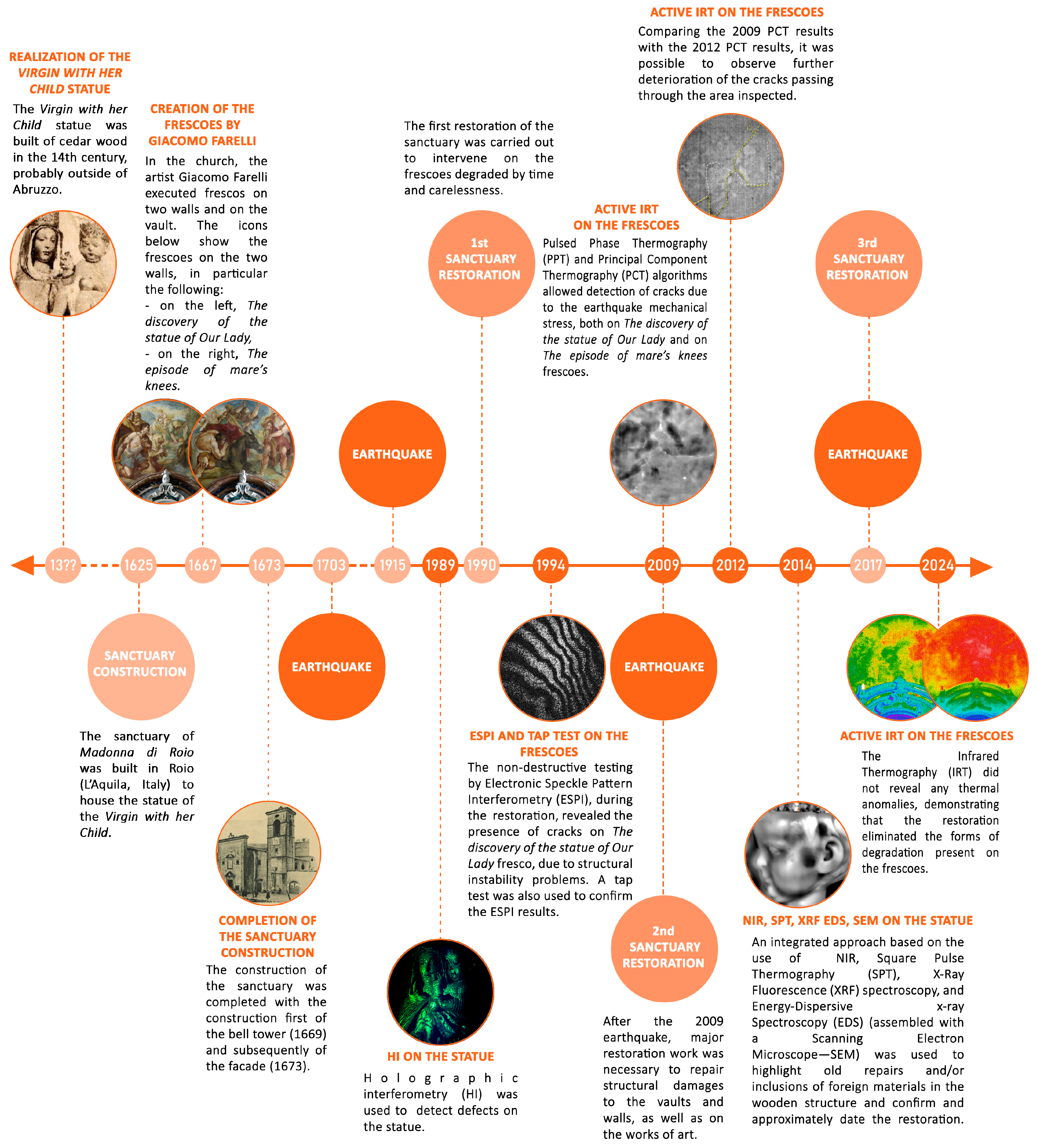

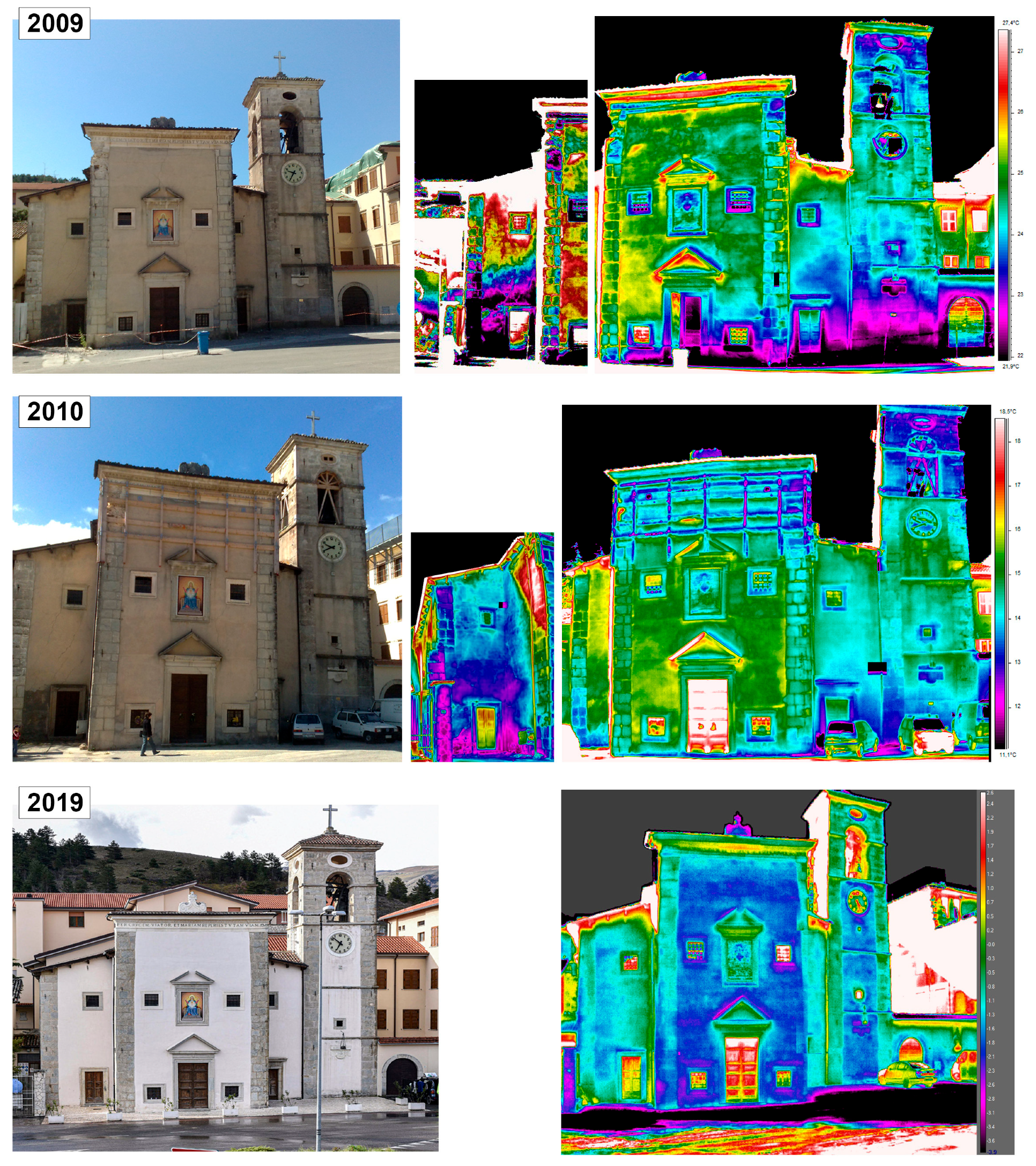


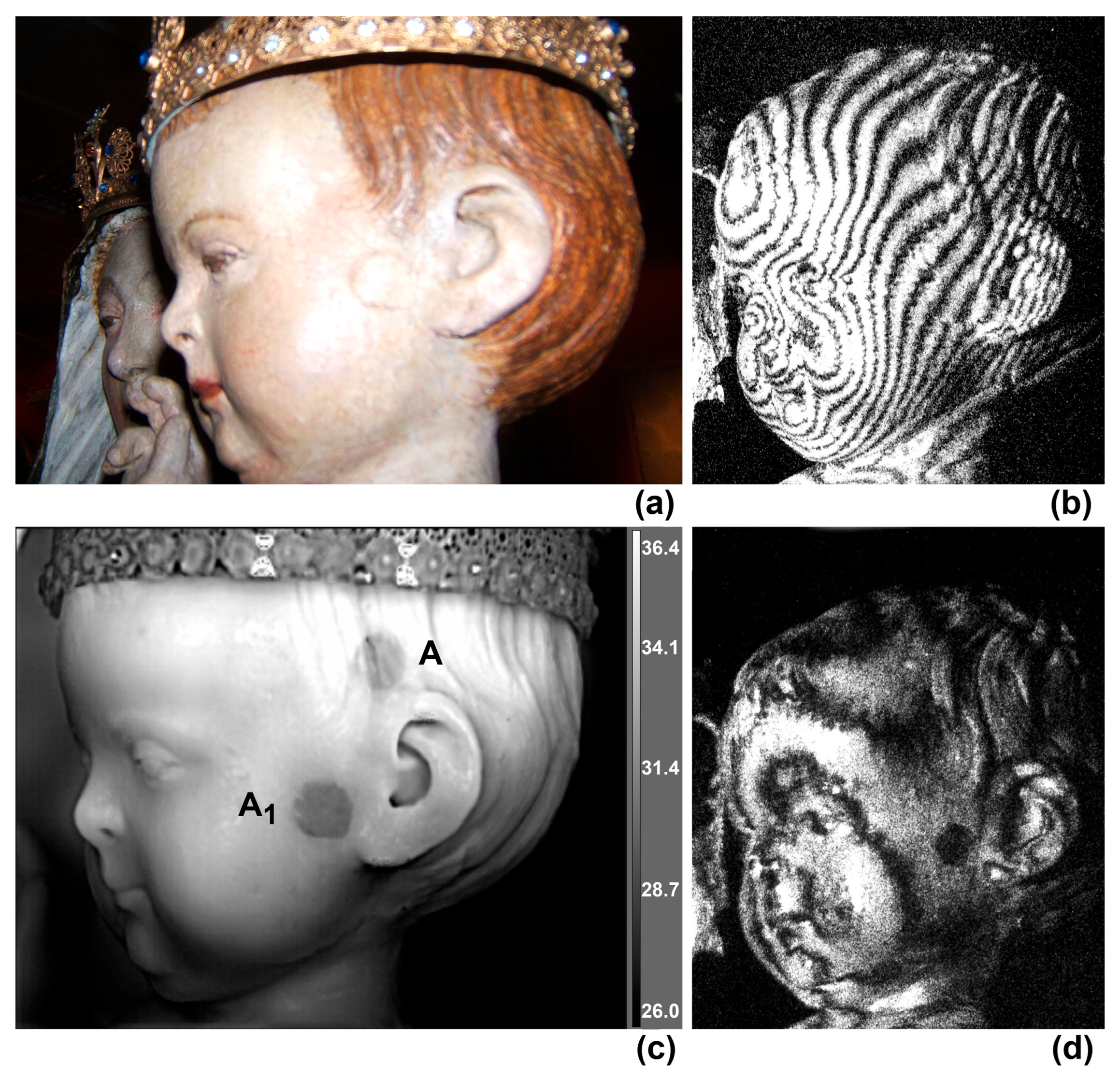
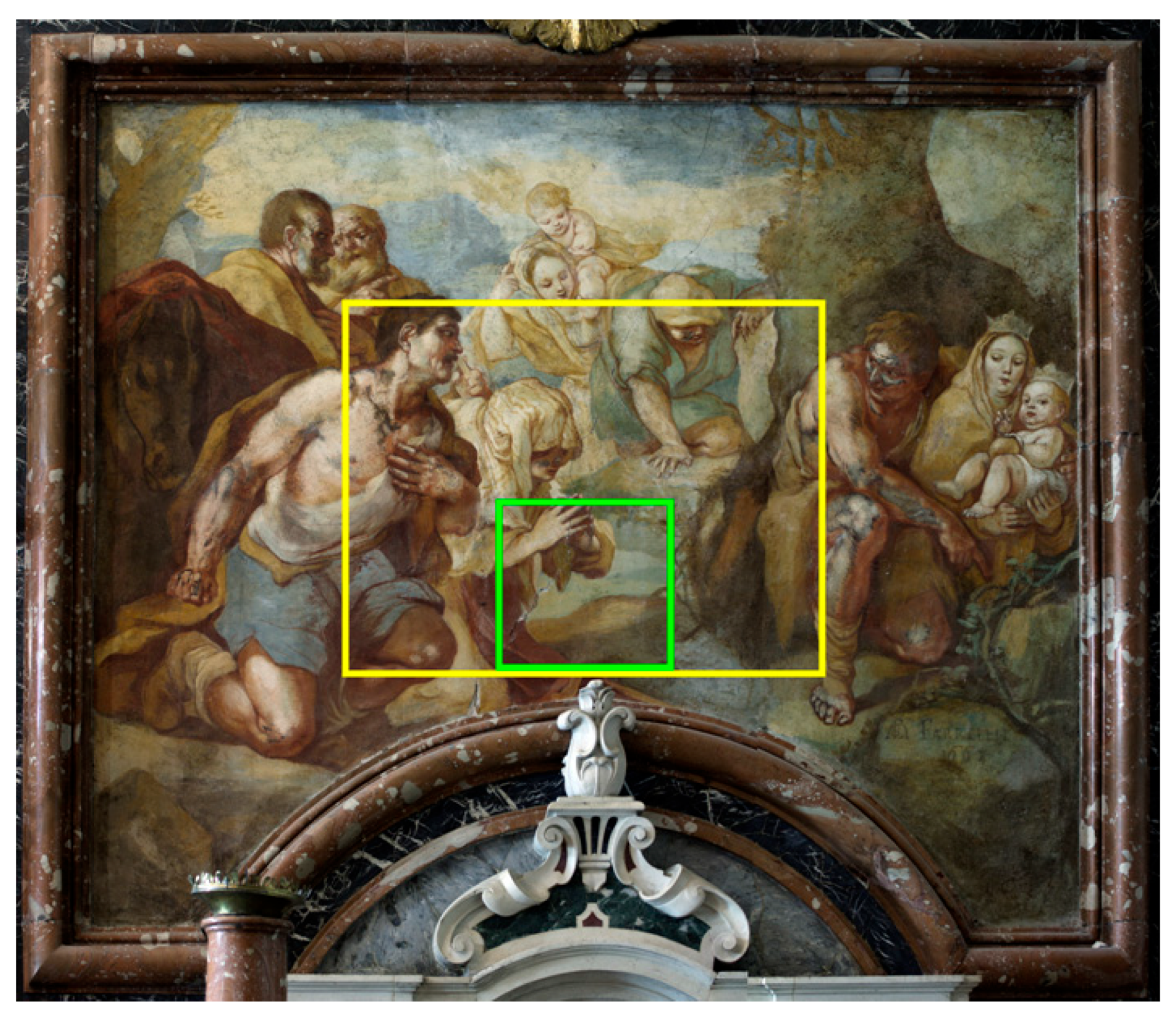
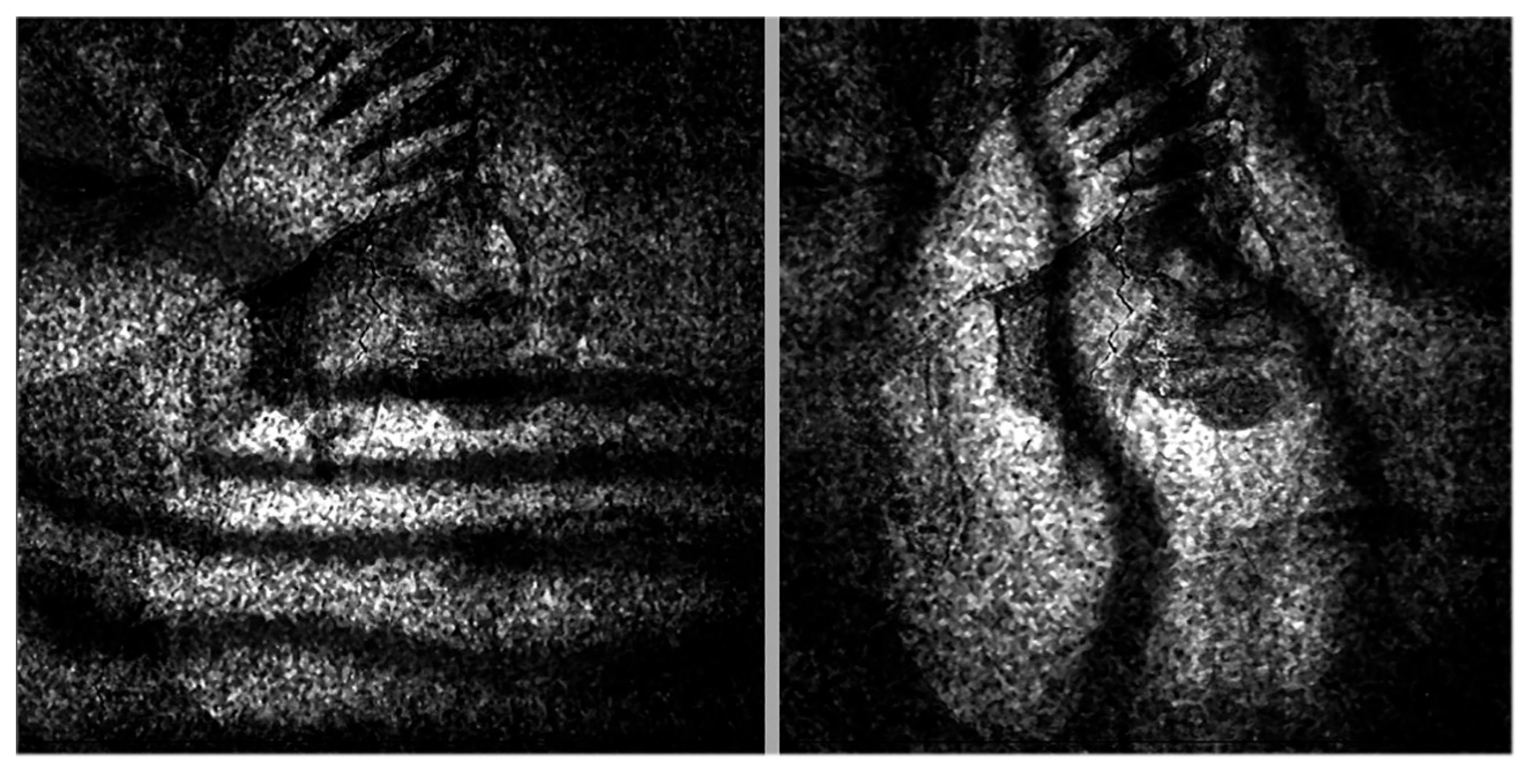
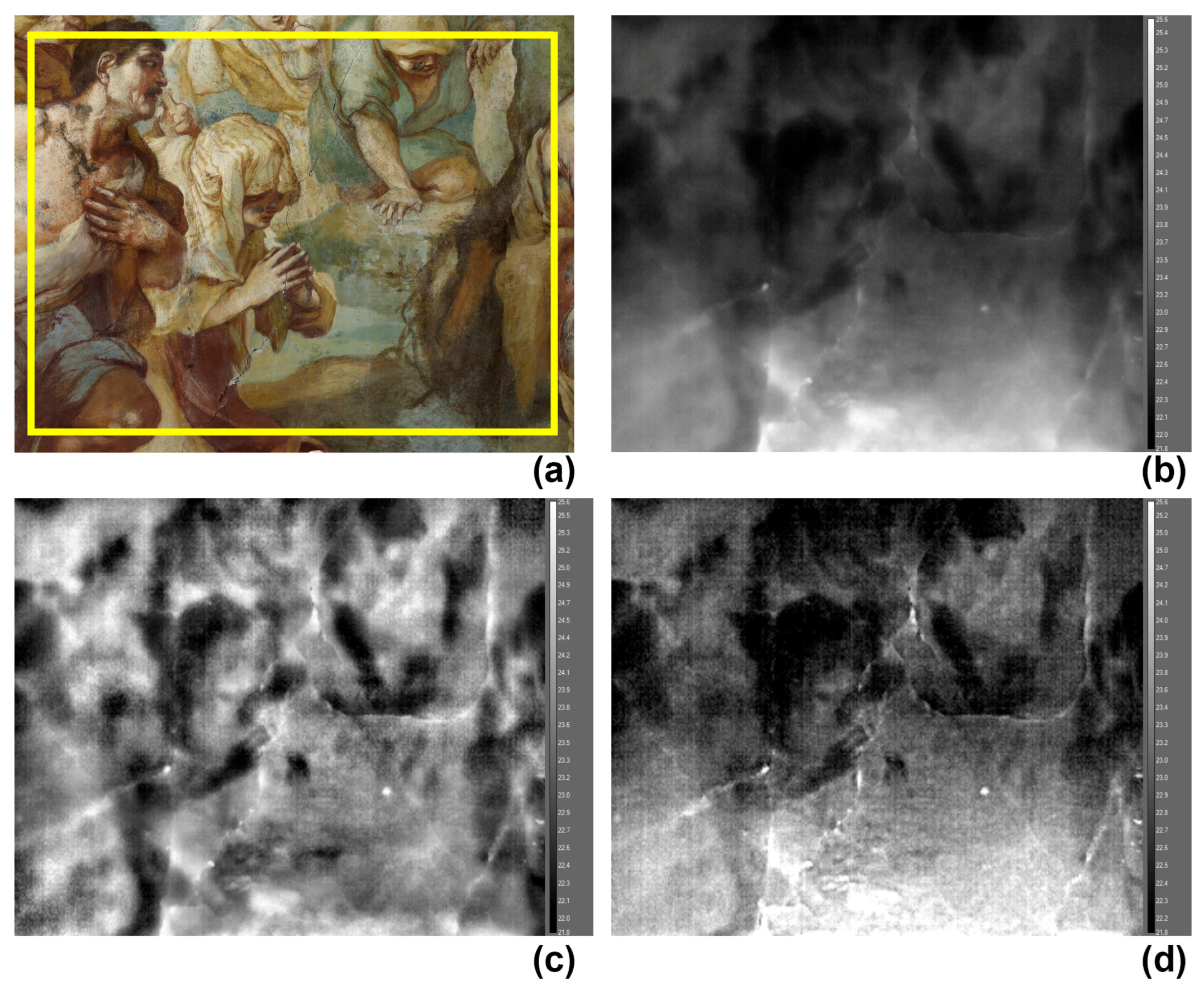
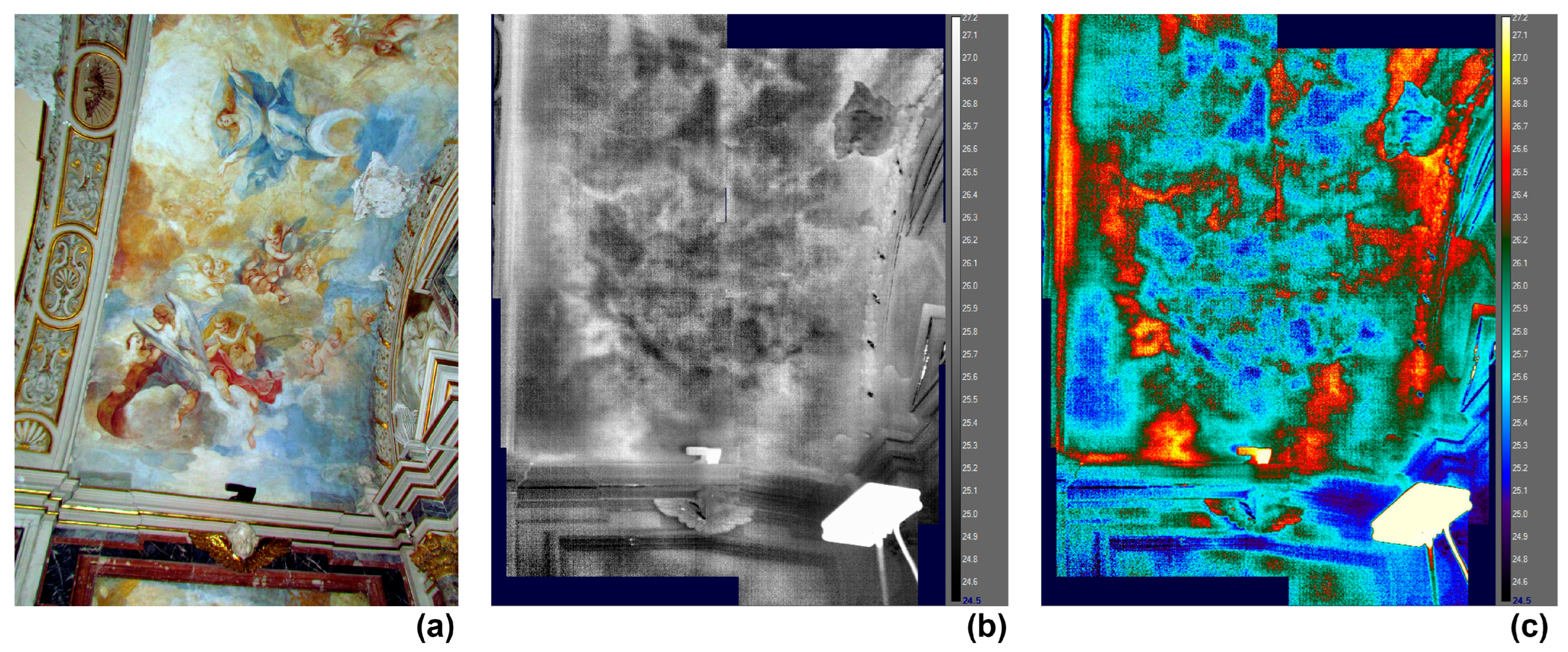

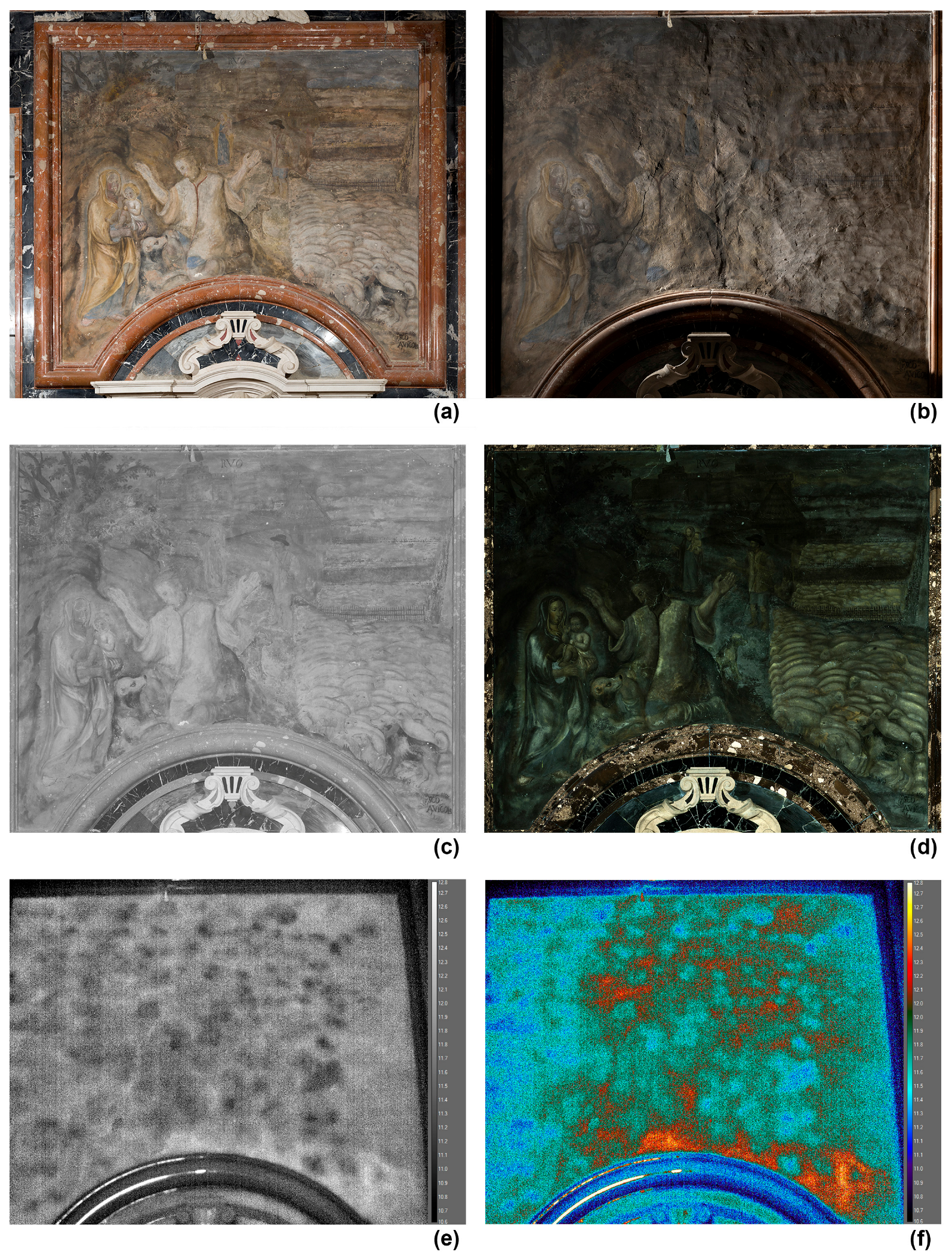
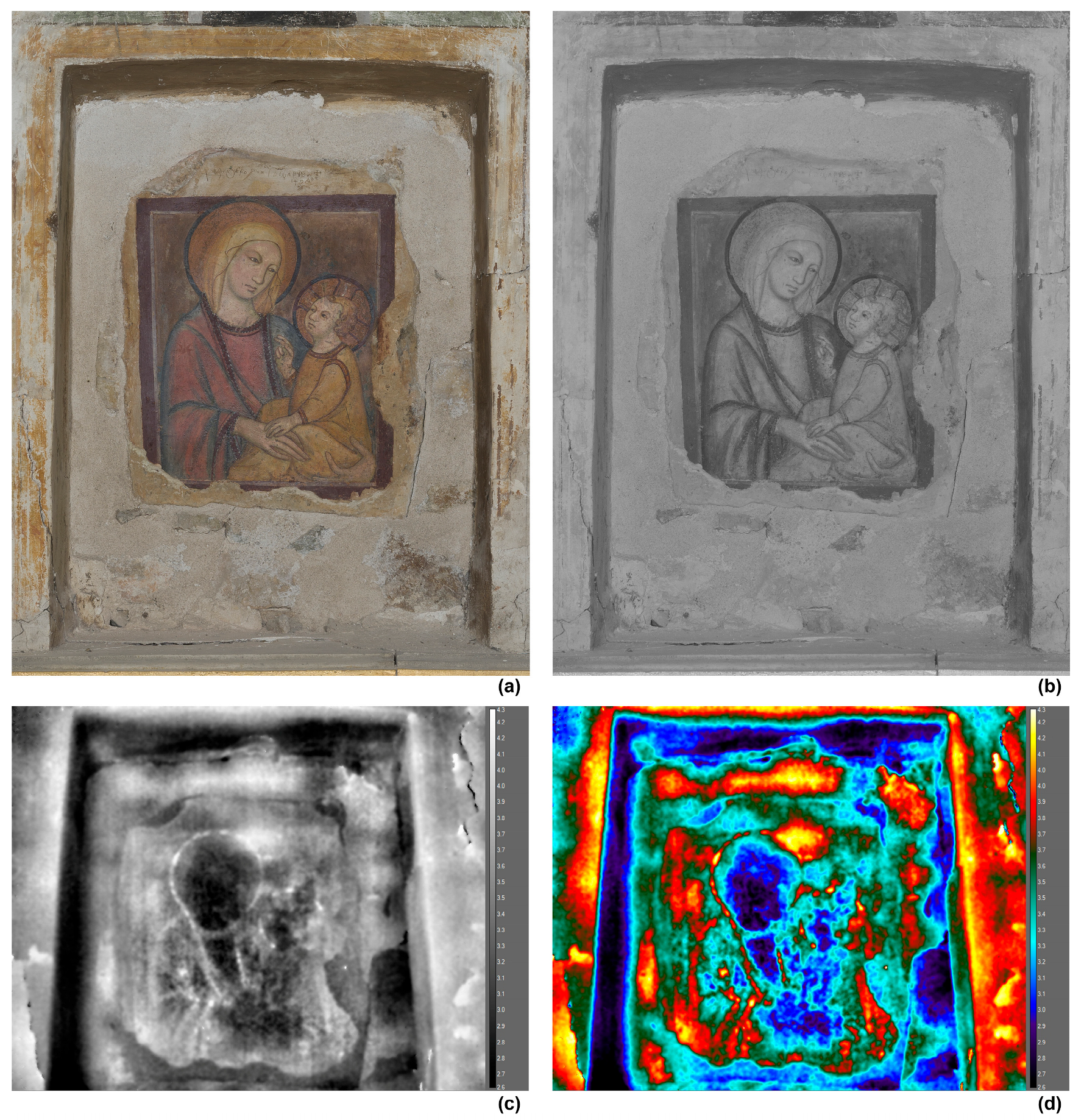
| Model | Year | Resolution | Temperature Range | Thermal Sensitivity/NETD | Dimensions/Weight |
|---|---|---|---|---|---|
FLIR T1030sc | 2021 | 1024 × 768 UltraMax® 2048 × 1536 | −40–2000 °C | <20 mK @ 30 °C | 168(W) × 206(D) × 188(H) mm 2.0 kg |
FLIR S65 HS  | 2005 | 320 × 240 | −40–1500 °C | <50 mK | 100(W) × 250(D) × 190(H) mm 2.0 kg |
AVIO TVS−2000MkII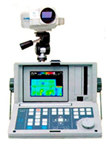 | 1995 | 256 × 200 | −40–300 °C | <100 mK @ 30 °C | Camera Head: 185(W) × 300(D) × 181(H) mm 3.8 kg Processor: 300(W) × 400(D) × 170(H) mm 9.0 kg |
Disclaimer/Publisher’s Note: The statements, opinions and data contained in all publications are solely those of the individual author(s) and contributor(s) and not of MDPI and/or the editor(s). MDPI and/or the editor(s) disclaim responsibility for any injury to people or property resulting from any ideas, methods, instructions or products referred to in the content. |
© 2025 by the authors. Licensee MDPI, Basel, Switzerland. This article is an open access article distributed under the terms and conditions of the Creative Commons Attribution (CC BY) license (https://creativecommons.org/licenses/by/4.0/).
Share and Cite
Paoletti, D.; Pasqualoni, G.; Mignemi, A.; De Leo, C.; Ciccozzi, A.; de Rubeis, T.; Ambrosini, D. Thirty-Five Years of Non-Destructive Testing in Santa Maria Della Croce di Roio Church, L’Aquila, Italy (A.D. 1625): Assessing the Impact of Restoration and Seismic Events. Heritage 2025, 8, 446. https://doi.org/10.3390/heritage8110446
Paoletti D, Pasqualoni G, Mignemi A, De Leo C, Ciccozzi A, de Rubeis T, Ambrosini D. Thirty-Five Years of Non-Destructive Testing in Santa Maria Della Croce di Roio Church, L’Aquila, Italy (A.D. 1625): Assessing the Impact of Restoration and Seismic Events. Heritage. 2025; 8(11):446. https://doi.org/10.3390/heritage8110446
Chicago/Turabian StylePaoletti, Domenica, Giovanni Pasqualoni, Antonio Mignemi, Cinzia De Leo, Annamaria Ciccozzi, Tullio de Rubeis, and Dario Ambrosini. 2025. "Thirty-Five Years of Non-Destructive Testing in Santa Maria Della Croce di Roio Church, L’Aquila, Italy (A.D. 1625): Assessing the Impact of Restoration and Seismic Events" Heritage 8, no. 11: 446. https://doi.org/10.3390/heritage8110446
APA StylePaoletti, D., Pasqualoni, G., Mignemi, A., De Leo, C., Ciccozzi, A., de Rubeis, T., & Ambrosini, D. (2025). Thirty-Five Years of Non-Destructive Testing in Santa Maria Della Croce di Roio Church, L’Aquila, Italy (A.D. 1625): Assessing the Impact of Restoration and Seismic Events. Heritage, 8(11), 446. https://doi.org/10.3390/heritage8110446








